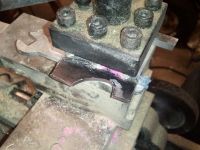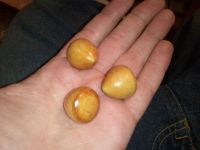 Registered Member #49
Joined: Thu Feb 09 2006, 04:05AM
Registered Member #49
Joined: Thu Feb 09 2006, 04:05AM
Location: Bigass Pile of Penguins
Posts: 362
|
Something a little different, but quick and rewarding should you wish to duplicate it.
A solid of constant width is a solid body that, when trapped between two parallel planes, measures the same width for all orientations. A circle is an obvious example, but more complex arrangements are possible.
Youtube has a video of several such solids showing how cool they are and potentially fun to fool around with on one's desk: 
The Reuleaux triangle is a 2d example:

A 3d example can be constructed by revolving the Reuleaux triangle around the axis of symmetry that passes through any vertex, producing an acorn-like shape. The same applies to any polygon with an odd number of vertexes and "Reuleaux" geometry.
Note many other designs satisfy the criteria - sharp corners or even symmetry are not required. Rounded corners are convenient from a manufacturing standpoint.

I cut a piece of steel on my CNC mill and then popped it into the lathe to cut such marbles out of scrap wood - this one was done for a 3-sided solid obviously:

And the finished results:

Should you wish to duplicate, here is a matlab script that a) generates 2d polygons of constant width with any number of sides and any corner radius, and b) outputs Gcode toolpaths to create the cutting tool (or even program your lathe directly, should it be so equipped).
%CWS generator
%Andrew Maurer
clear all
close all
sides=3 %Must be odd integer
rc=0.125 %Corner/cutter RADIUS
r=1 %"Statutory" width of solid
for i=1:sides
centers(i,:)=[(r/2-rc)*sin(2*pi*i/sides) (r/2-rc)*cos(2*pi*i/sides)]
end
plot(centers(:,1),centers(:,2), '*')
hold on
dtex=norm(centers(1,:)-centers(floor(sides/2)+1,:))
axis square
axis equal
grid on
k=1
for i=1:sides
for t=0:ceil(r/rc)/2:floor(180/sides)
theta = 360*i/sides-90/sides+t
plot(centers(i,1)+rc*sin(theta*2*pi/360), centers(i,2)+rc*cos(theta*2*pi/360),'.r')
ptcld(k,:)=[centers(i,1)+rc*sin(theta*2*pi/360), centers(i,2)+rc*cos(theta*2*pi/360)]
k=k+1
end
for t=0:floor(180/sides)
i2=i+ceil(sides/2)
if i2>sides
i2=i2-sides;
end
theta = 360*i2/sides-90/sides+t
plot(centers(i2,1)+(dtex+rc)*sin(theta*2*pi/360+pi), centers(i2,2)+(dtex+rc)*cos(theta*2*pi/360+pi),'.g')
ptcld(k,:)=[centers(i2,1)+(dtex+rc)*sin(theta*2*pi/360+pi), centers(i2,2)+(dtex+rc)*cos(theta*2*pi/360+pi)]
k=k+1
end
end
figure
i=1
while i<size(ptcld,1)
if ptcld(i,1)<0
ptcld(i,:)=[]
else
i=i+1
end
end
vline=[0 max(ptcld(:,2))+r/2]
for i=2:100
vline(i,:)=[vline(i-1,1) vline(i-1,2)-r/200]
end
vline2=[0 min(ptcld(:,2))]
for i=2:100
vline2(i,:)=[vline2(i-1,1) vline2(i-1,2)-r/200]
end
ptcld=[vline;ptcld;vline2]
ptcld=sortrows(ptcld,2)
plot(ptcld(:,1),ptcld(:,2),'b')
axis square
axis equal
k=1
for i=min(ptcld(:,2)):r/200:max(ptcld(:,2))
y=i;
[poo mindex]=min(abs(ptcld(:,2)-y));
x=ptcld(mindex,1);
d=0;
while d<rc
d=99e9;
for i=1:size(ptcld,1)
dt=norm([x y]-ptcld(i,:));
if dt<d
d=dt;
end
end
if d<rc;
x=x-r/500;
end
end
hold on
plot(x,y,'r*');
%drawnow
cnc(k,:)=[x y];
k=k+1;
end
fid = fopen('out.iso', 'w');
for i=1:size(cnc,1)
fprintf(fid, 'G01 X%6.6f Y%6.6f F1\n', cnc(i,1), cnc(i,2));
end
fclose(fid);
Here's an example output for a constant-width pentagon w/ "width" = 1, and 0.125 radius corners.

The toolpath output is very basic - just a single profile pass along the "edge" of a cutting tool as shown. In blue is the profile of the tool to be created. The mill toothpath is shown in red. Note that the tool diameter is assumed to be the same as the diameter of the corners - I used a 1/4" endmill in the photos shown.

|

